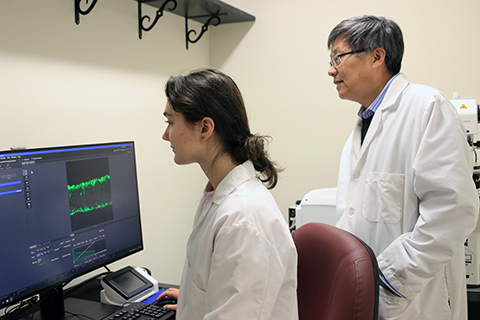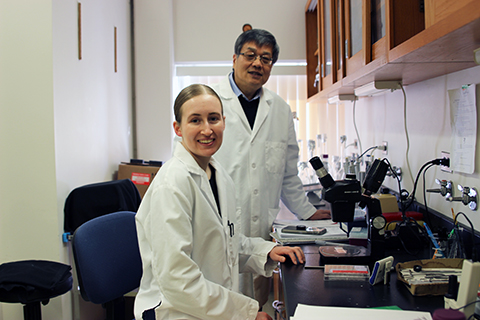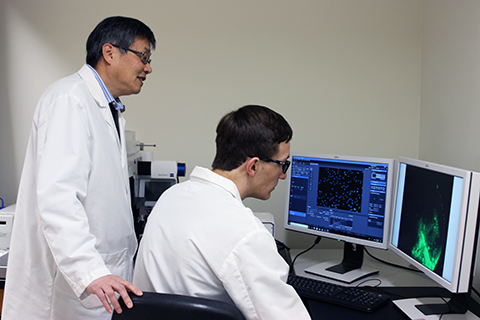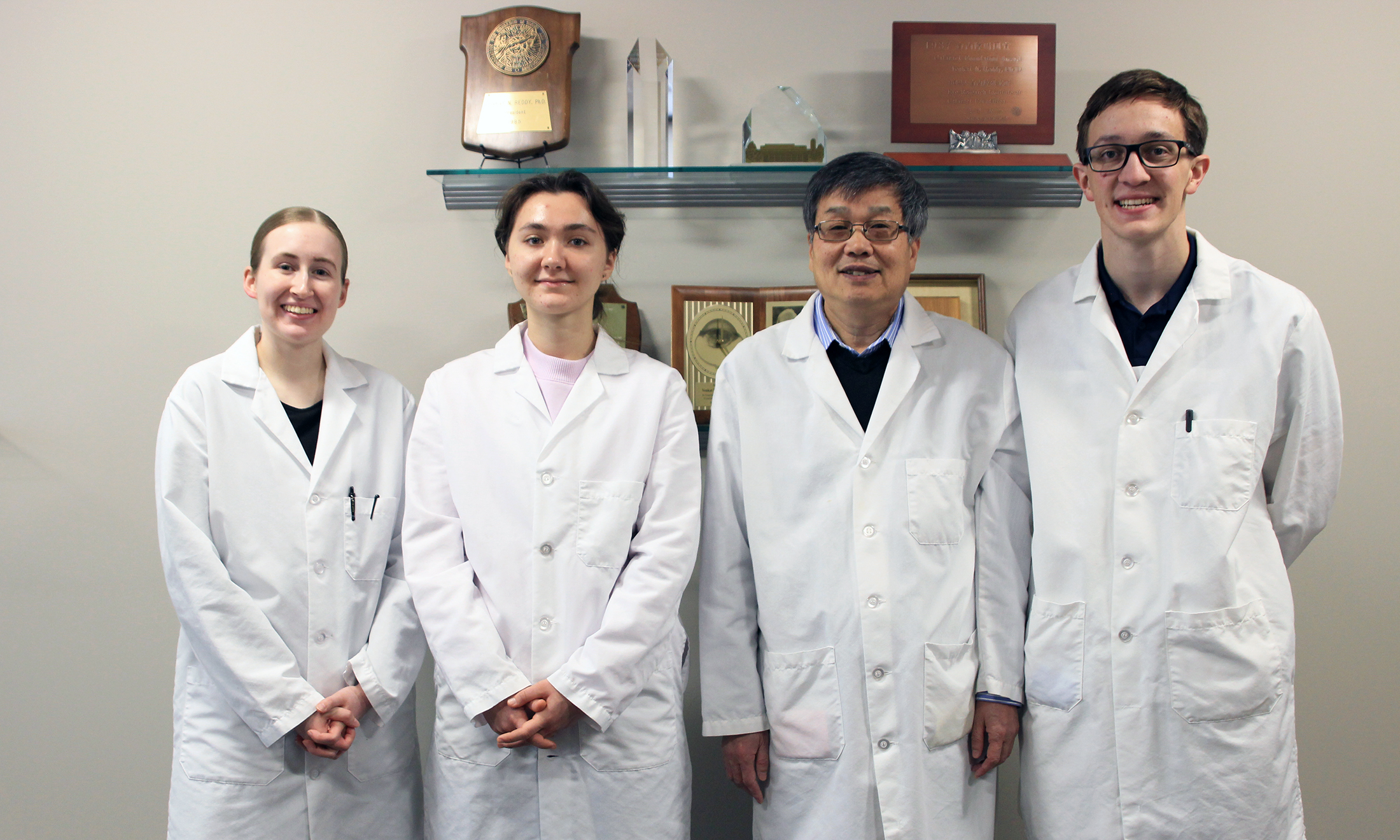OU researchers investigate vision impairment affecting premature infants
Each year, nearly 40,000 infants (10% of total live births) are born prematurely (before 37 weeks of gestation) in the United States, and that number is growing. Premature infants have a high risk of developing lifelong low vision. Their eyes can also develop myopia, a common vision condition in which near objects appear clear, but objects farther away look blurry.

Stephanie BumBru, undergraduate student in biomedical sciences, with Dr. Zhang.
The visual impairments associated with premature birth cannot yet be cured or prevented because researchers do not yet understand the causes and mechanisms responsible for them. A group of researchers at Oakland University’s Eye Research Institute is investigating these questions in order to pave the way for treatments of diseases such as Retinopathy of Prematurity, an eye disease affecting premature infants.
Their efforts are supported by a pair of grants from the National Eye Institute, which is part of the National Institutes of Health. Both grants are overseen by principal investigator Dao-Qi Zhang, associate professor of biomedical sciences.
A $429,016 R15 grant will be used to identify “pacemaker” cells that generate spontaneous retinal wave activity, which is crucial to the development of healthy vision.
“Prior to birth, retinal neurons self-generate electrical voltages called bioelectricity. The spontaneous bioelectricity travels periodically across the retina, like waves, and then propagates to the brain via the optic nerve, the fiber track connecting the retina to the brain’s visual system,” Dr. Zhang explained.

Heather Durfee, doctoral student in biomedical sciences, with Dr. Zhang.
“The project will advance knowledge of how spontaneous retinal wave activity triggers development of neuronal cells in the retina and how these cells promote right and left eye visual field separation in the brain.”
While spontaneous retinal waves are critical for retinal neuronal development and for promoting right and left eye visual field separation, “pacemaker” cells that generate retinal waves have not been well identified and the function of retinal waves in eye development remains poorly understood.
Furthermore, researchers believe that early termination of retinal waves may cause neurological and vision problems.
“Because spontaneous neural activity appears in the visual processing brain center of the pre-term human fetus and prenatal primate retinas, the early termination of spontaneous neural activity in infants born prematurely may cause neurological disorders and visual impairment,” Dr. Zhang noted. “Our work will increase understanding of the cellular and neural circuit mechanisms of neurodevelopmental disorders and vision problems in premature infants.”
The R15 award will support one Ph.D. student and six undergraduate researchers over a three-year period. The student researchers will learn advanced techniques, develop independent critical thinking skills and present research results to the scientific community, which Dr. Zhang noted, will serve them well in their future professional careers in biomedical research and medicine.

Adam Schmitz, undergraduate student in biomedical sciences, with Dr. Zhang.
The student researchers include Heather Durfee, a doctoral student in biomedical sciences, and Adam Schmitz and Stephanie BumBru, undergraduate students in biomedical sciences. Additional student researchers will be hired in the near future.
In parallel with the R15 award study, a $1,632,209 R01 award has several goals associated with understanding the role of spontaneous retinal wave activity in the development of healthy vision. The first goal of the R01 award is to determine the role of spontaneous retinal wave activity in eye development when the eye is closed during gestation.
“Specifically, we will identify a novel neural pathway in which spontaneous wave activity first triggers the release of dopamine, a molecule that plays a critical role in the central nervous system, and then determine whether dopamine regulates retinal blood vessel development, which impacts the development of the eye,” said Dr. Zhang. “This study will provide the first evidence that retinal wave activity is key for triggering ocular growth during development and that its disruption by prematurity may be involved in the development of vision impairments.”
The second goal of the R01 project is to determine how oxygen-induced retinopathy (OIR) causes vision impairment and myopia.
Postnatal oxygen therapy (due to preterm infants’ lungs not working well enough to get sufficient oxygen from the air) may cause regression of existing blood vessels, thereby enlarging areas that lack blood vessels. When supplemental oxygen is discontinued, it can induce new abnormal blood vessel growth known as Retinopathy of Prematurity (ROP).
Approximately half of premature infants develop mild to severe ROP. Severe ROP can cause impaired vision or even blindness. Although mild or even moderate ROP can resolve with and without treatment, infants with a history of ROP are still at high risk of developing lifelong eye problems and myopia. However, the mechanisms by which ROP causes myopia are unknown.
“We have previously reported that OIR causes the loss of retinal dopamine neurons, resulting in ocular dopamine deficiency. We will assess whether and how ocular dopamine deficiency causes the development of myopia,” said Dr. Zhang. “This work will advance our knowledge of how pre-term infants suffer from lifelong low vision and myopia, and whether dopamine supplements may help to slow the development of myopia.”
Dr. Kenneth Mitton, from the Eye Research Institute, is a co-investigator on this project, providing an on-campus collaboration opportunity for Dr. Zhang's lab. In addition, Dr. Michael Iuvone from Emory University (Georgia), who is a pioneer in the field of myopia and dopamine signaling, is also a co-investigator on the project.
Dr. Zhang added that securing these competitive grants was made possible through OU’s strong research environment, including:
- A robust partnership between the Eye Research Institute and the Oakland University William Beaumont Eye Research Center.
- Shared facilities across the campus, including OU ERI, OUWB ERC, and the Department of Biological Sciences in the College of Arts and Sciences.
- Undergraduate Research Programs across the campus such as the Summer Undergraduate Program in Eye Research (SUPER), the Center for Biomedical Research’s Summer Undergraduate Research Program, the Honors College thesis program, the Undergraduate Student Independent Research Program, and OU Summer Student Campus Corps.
- Research development, facilities and resources provided by the OU Research Office
- Bridge funding provided by OU’s Center for Biomedical Research


 November 15, 2023
November 15, 2023







